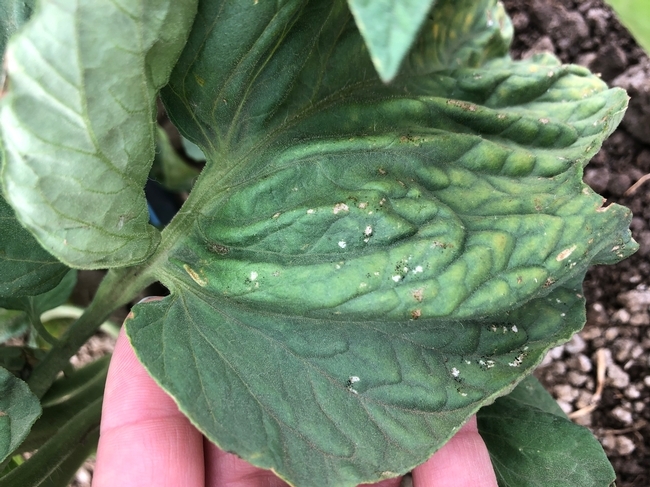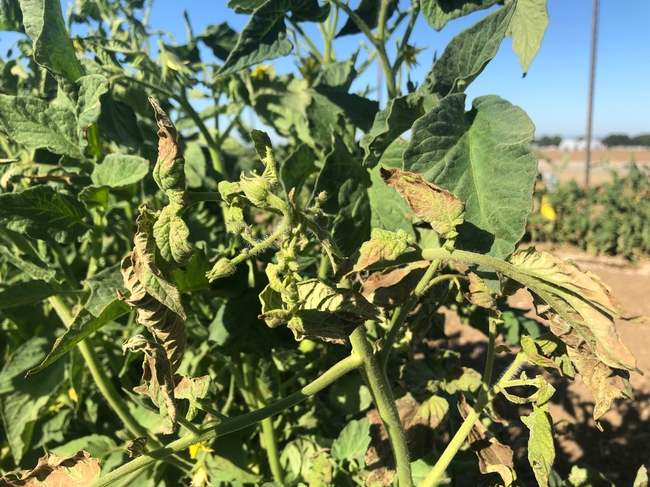What does this mean for you? Predicting thrips to manage tomato spotted wilt virus in organic production
Tomato spotted wilt virus (TSWV), transmitted by western flower thrips (Frankliniella occidentalis), is widespread in Yolo/Solano/Sacramento counties and can cause severe damage to fresh market tomatoes and peppers. Using a piercing-sucking mouthpart, thrips damage appears as small white/silver/grey patches (see photo). To confirm the presence of thrips, lightly shake a plant onto your hand or a dark surface and use a hand lens to look for the insect, or take a hand lens to the leaf damage and check for thrips. Young plants infected with TSWV are stunted with leaf bronzing (see photo), while mature plants have green and red fruit that are bumpy and deformed and typically show diagnostic ringspots (often concentric in green fruits). TSWV diagnosis can be made onsite using an ImmunoStrip, available from your local farm advisor.
In the spring, the first or second generation of thrips are mostly free of the virus. After breeding on plant reservoirs infected with the virus, third generation virus-carrying winged adults can start spreading TSWV into crops, especially pepper and tomato. Virus reservoirs include weedy species and some cultivated ones, including fava beans, lettuce and radicchio. New findings suggest that another early season reservoir is infected pupae overwintering in soil.
Once the crop has some level of viral infection, the weeds become much less important, simply because the sheer number and density of infected crop plants (peppers and tomatoes) generally outnumbers the presence of weeds. For this reason, diligently rogueing young, symptomatic plants can significantly benefit your stand and is an important part of increasing the efficacy of a spray program.
In the case of processing tomatoes, plants are sensitive to attack pre-flowering. Once fruit is set, new infections tend to only cause "strikes" that kill or damage only one branch, but large plants are rarely killed and the fruit is still usable for paste. This has not been verified for fresh market tomatoes, but can be considered when making your own observations over the season.
What that means for virus control is that there's a window of a couple of months when the crop is at risk - corresponding to the third, fourth and maybe fifth generations of thrips. The Gilbertson and McRoberts lab in the UC Davis Department of Plant Pathology have developed a degree-day model to track and predict thrips generations. Here, you can see the status for Yolo County, which says on June 3 we are at Generation 2, peak adult. Generation 3, peak adult is expected to be June 28. By managing thrips populations during this Generation 2 window, plants are allowed the chance to grow past the danger period and, importantly, the number of virus-carrying adult thrips is reduced early in the season, thereby slowing overall spread. Fresh market production may differ in that infection is likely a problem at any time because virus symptoms on fruit will make them unmarketable. However, the differences between fresh market and processing tomatoes have not been examined.
Genetic resistance is available. Varieties with the Sw5 gene are resistant to infection and do not show symptoms (in pepper there is another gene, Tsw, that confers resistance to TSWV). Originally isolated from wild tomato species from Peru, traditional breeding is being used to develop resistant cultivars that are effective against new resistance-breaking (RB) strains of TSWV. Resistance-breaking (RB) TSWV strains are present in California and other parts of the world, but are currently not very prevalent in Northern California.
Organic pesticide control of thrips is challenging, but can potentially play a role in reducing the impact and/or timing of an infection. Organically approved products for thrips control include spinosad or pyrethrum-based products, in addition to some botanicals. It's often important to combine a product with an adjuvant such as Oroboost, Vista Sil or others to increase leaf coverage and residual activity. Regular applications will be required for continued thrips control. Alternatively, protection from thrips can also be achieved by protecting plants with insect nets early in the season.
Do you control for thrips? If so, how? Are you growing fresh market varieties with TSWV-resistance? I'd love to hear your story.
Thanks to the UCD Department of Plant Pathology—Bob Gilbertson and Neil McRoberts, for their contributions to this article. This post is originally from the Small and Organic Farm Advisor blog.

